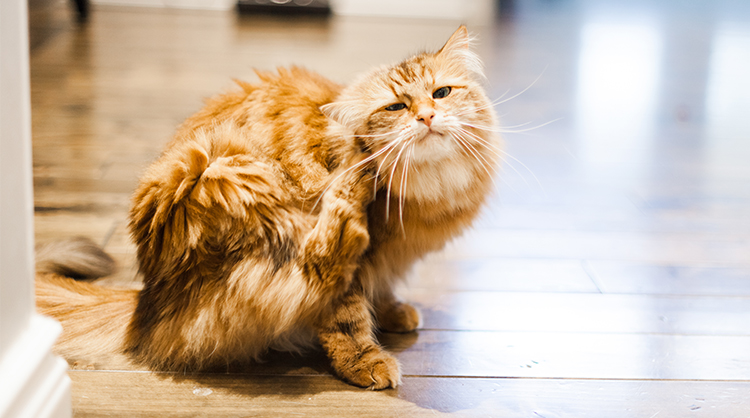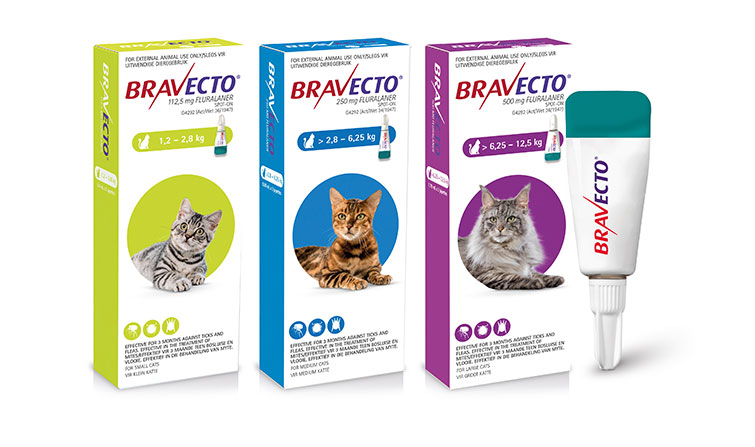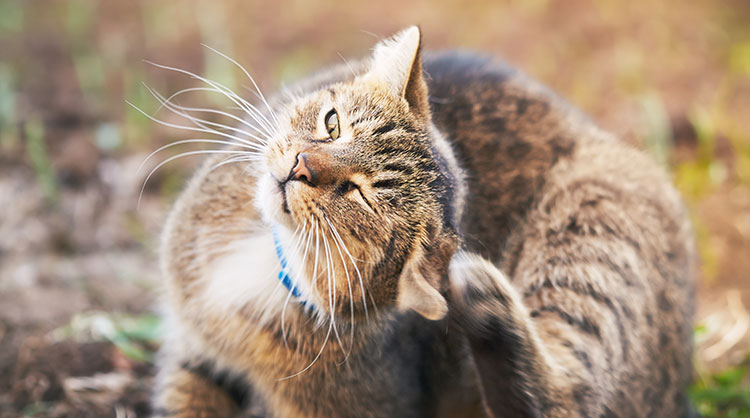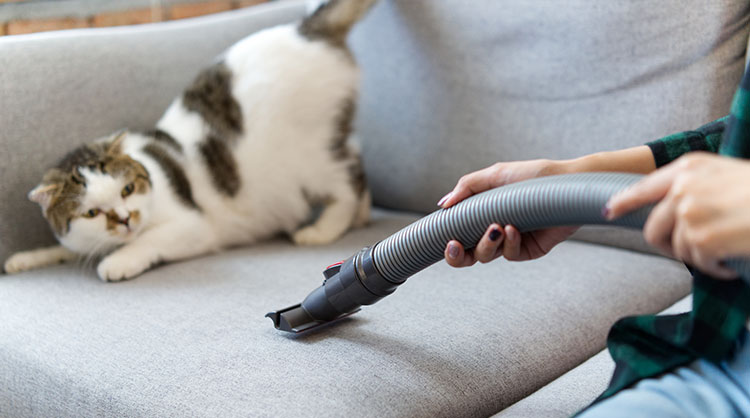How To Get Rid Of Fleas On Cats
CATS FLEAS

Posted by bravectosouthafrica – 24 June 2019
Guide Overview
- Tips for treating outdoor and indoor cat fleas
- What are fleas, and where do they come from?
- Wrapping your head around the flea life cycle
- Learn how to identify cat fleas and their symptoms
- How to prevent cat fleas in your home
- Use a long-lasting treatment
- Vacuum in your house regularly
- What you can’t steam, wash
- How to prevent cat fleas in your backyard
- Why choose Bravecto®
- Read through our frequently asked questions (FAQs) about Bravecto®
- Get your dose of Bravecto® today!
Tips for treating outdoor and indoor cat fleas
Fleas – a pet owner’s nightmare. First, these fast-spreading parasites climb into your cat’s warm, fluffy coat and feed on their blood. And without even asking, they enter your house and infest your personal belongings for weeks (or even months) at a time. We provide an explanation on how to treat cat fleas.
There are few things as frustrating as a cat flea infestation, especially when it’s reoccurring and you’re unable to control these horrible pests. While cat fleas on humans are easily identified by flea bites on your skin, cats will simply scratch and suffer in silence; because these parasites are so tiny that you need to strain your eyes to catch a glimpse of a flea in action.
But the real question is, where do cat fleas come from and how can you get rid of them?
What are fleas, and where do they come from?
Cat fleas are small, wingless insects that feed on warm-blooded animals. There are almost 2000 species of fleas that have been identified across the globe. However, the most common species in South Africa are cat fleas (Ctenocephalides felis), dog fleas, human fleas and rat fleas which all differ. Did you know that cats’ bedding may support a flea population of 8000 immature and 2000 adult fleas.” This proves how easy it is for fleas to multiply in your home. Bravecto® Spot-On For Cats can offer your pet 3 months of protection against these parasites.

If you allow your feline to explore outside, it’s almost sure that your cat will pick up fleas while they’re out hunting and exploring their neighbours’ backyard. If your garden is filled with mess and clutter, your cat is even more susceptible to fleas as they love to breed in moist places. And trust us, it’s almost certain that your cat will explore these areas to search for gifts to bring home to you. So, to avoid this, trim your trees and garden beds to prevent infestations.
Now, once your cat has explored the outdoors, they will come back inside and seek attention. If your cat has fleas, they will bring them into your home. While these indoor cat fleas might not create a sudden infestation that affects you, they will live dormant for weeks before they emerge from their cocoon to feed. According to this article, “at any given time, about 57% of the fleas in someone’s home are in the larval stage.” This is a scary thought. “These larvae spin a cocoon to live in, where they develop into a pupa. After a week or two of development, they grow into an adult. The adult flea may remain in the cocoon for up to five months until the vibration or presence of carbon dioxide from a passing animal triggers it to awaken.” Based on these insights, it’s evident that fleas can enter your home regardless of how sanitised it is.
It’s integral that pet parents monitor their pets and make sure they’re clean. It takes more than using the best treatment – if you’re not cleaning your cat’s environment and providing healthy sanitation for your dearest feline friend, you’re constantly going to battle with cat fleas and ticks. It’s important to speak to your vet about dealing with cat fleas. Bravecto® Spot-On For Cats offers 3 months of protection against ticks and fleas with just one application. Speak to your local vet for an appropriate tube that works accordingly for your cat’s weight.

Wrapping your head around the flea life cycle
It’s often easy to live past your cat’s peculiar behaviour. But if you take the time to regularly comb your cat and rub his soft coat, you will be able to monitor their skin and ensure they’re not suffering from cat fleas. If, on the other hand, you do not pick up that your furry friend is suffering over a long period of time, it could lead to serious, life-threatening diseases.
Depending on the age of your cat, for instance, if it’s still a kitty, the dangers differ drastically. Kittens are prone to getting tapeworms if fleas are swallowed. If fleas heavily infest them, they may develop an allergic reaction to saliva from the flea bites. And, of course, much like with puppies, the biggest danger is your kitty developing anemia from fleas.
The flea lifecycle can be anything from two weeks to 42 days long, depending on the conditions and whether the host is nearby or not. According to this article, “adult cat and dog fleas can live up to one year in ideal situations, but only about one to two weeks if no host is present.” So, why not save yourself the hassle and forgetfulness and switch to Bravecto® Spot-On For Cats which will give your cat 3 months of uninterrupted protection against ticks and fleas. Our innovative Dose Reminder App can remind first-time cat owners when to treat their fur ball. This will prevent any costly (or unexpected) blow out, and it will give your cat the long-term coverage they deserve. It’s no use trying to cure an infestation when monthly treatment options might lead to gaps in your coverage. If you’re going to fight fleas, do it properly.
Read why pet owners love using Bravecto®
Hi Bravecto® South Africa this is my boy Breezy. He is literally my best friend. When I first heard about Bravecto®, it sounded too good to be true. There was no way that one [product] could be so effective for 12-weeks. But there came a time when I was desperate to help my boy get rid of the ticks and fleas. He would lay there scratching, and I could see it in his eyes that he was unhappy, so I decided to give it a try. To my amazement, in literally 10 minutes after giving him the [product], I could see the ticks and fleas falling off. I stood there in shock. I could not believe my eyes. I am so grateful for this product. Breezy is much more happy, full of life and full of energy.
– Kurt Richards.
Meet Mr Snuffles and see how you can give your cat 3-months protection they deserve

Learn how to identify cat fleas and their symptoms
Now that we’ve answered the question, “what are fleas?” and explained the flea lifestyle, it’s important to learn how to identify cat fleas on your cat. Before you consider the different symptoms of cat fleas, look in the following places on your cat: their groin, armpits and ears. These are the most common areas for cat fleas to hide, as they are warm and moist. If you notice inflammation on their tail or belly, it’s because they’ve been scratching those areas too, hopefully, to assist with the irritation of the areas mentioned above.
Some symptoms of cat fleas include your feline friend scratching their ears or shaking their head. They will also lick behind their legs, chew or bite themselves. And as a result of the constant scratching, you will slowly start to notice your cat’s fur loss on the top of their back as well as redness or blood in their ears. If you notice that your cat’s ears have a black coloured “dirt” coming out of them, consult a professional to ensure they’re not flea’s droppings.
If your cat is not scratching, it’s possibly the early stage of a flea infestation and can be challenging to identify. In these cases, you can comb your cat to have a closer, more detailed view of their fur. Or, alternatively, visit your local vet for further assistance. This is especially tricky for new pet owners. But over the years, you will learn to distinguish between the different parasites.

How to get rid of fleas on cats in your home
Considering how long these bloodsuckers can be present in your home, one flea control treatment is not enough. (Did you know that 1-5% of fleas will be found on your pet, the remaining 95% are present in your pet’s environment which is most-likely your home? It is for this reason that one flea control treatment may not be enough.) Stay persistent by treating your cat with a product that provides extended protection, and keep cleaning your house. After all, dealing with cat fleas can be a costly venture. If you want your pest control solution to be effective, you’d better keep at it. Depending on how bad the indoor cat fleas are, you might need to look at products that will treat your pet’s environment such as fumigating your house. But until then, here are three simple ways to prevent cat fleas in your home.

Use a long-lasting treatment
Do your homework and make sure to invest in a long-acting product that can protect your cat against any parasites such as cat fleas. Bravecto®, for instance, features an effective speed of kill that will continue to kill any new fleas that may jump onto your cat within hours of application. You can also wash your pet and its bedding to clean the fleas off of your cat during this process.

Vacuum in your house regularly
Whether you have carpets or not, it’s important to vacuum your floors. While you might think that you’re able to remove any unhatched eggs or fleas on your hands and knees, you’ll be surprised. As mentioned, fleas are difficult to see, hence the need to vacuum in cracks and small places where you wouldn’t be able to get to with a broom or cloth. Dispose of your vacuum bag immediately after use. Another tip when cleaning furniture is to hire a steam cleaner to help you do the job. Steam over your cat’s bed, couches, furniture, rugs and more. Once they feel the warmth from the steamer, they might emerge, making it easier for you to see them and get rid of them. Lastly, always attend to areas where your cat frequents. These are flea-ridden areas.

What you can’t steam, wash
Easier said than done but take off any fabric that can be washed. For instance, couch covers and bedding. These are great places for fleas to hide, so place them straight into the washing machine. The fleas will not survive warm water. *Please note, if you are just starting to get a handle on the flea problem, it’s important that you clean yours and your cats’ bedding regularly to control any existing infestation.

How to get rid of fleas on cats in your backyard
It’s a given that if your backyard is a mess, you are bound to struggle with fleas. Before you decide to tackle any open area, make sure that you look at your area strategically. Make sure that you map down the sunny, shady areas as this will determine where these parasites are more likely to live. While they enjoy moist areas, they do not enjoy the sun. You can easily complete this task by monitoring your cat’s movements and where he or she likes to spend their time hunting.

Begin by mowing your lawn
Time to bring out the lawn mower and address the long grass situation. Fleas love to dwell in the long grass as it’s easy to hide away and breed at the bottom. If possible, mow your lawn regularly and rake in between mowing stages. Once you have completed an area, put all the grass into a sealable bag to stop them from breeding in compost piles. While you’re busy, be sure to remove any leaves, twigs and debris from your garden to expose as much sunlight as possible.
Purchase plenty of cedar chips
If you want to refrain from using chemical products outside of your house, consider using cedar chips. These are natural wood chips that give off a smell that cat fleas do not like. So, if you are dealing with cat fleas and want to overcome the infestation naturally, use cedar chips to cover the areas where your cat sits as well as along fences and gates. By putting them in moist areas leading into your property, you will deter fleas from entering because of the smell of these chips.
Speak to a garden centre for recommended insecticides
Outdoor fleas are, excuse the pun, an absolute pest. The worst part about dealing with cat fleas is having to consider insecticides to prevent these parasites from breeding and infesting your home. If you’re battling a flea infestation and your current flea control programme is not working, speak with a local garden centre for some advice on the correct products to use. Make sure that you pack away all your cat’s toys to prevent your furry friend from coming into contact with any chemicals that may affect them. Always be cautious and use any form of insecticides safely.
Why choose Bravecto®?
It offers cats 3 months of extended protection against ticks, fleas and ear mites. This product is applied to the back of your cat’s head. After twelve hours of application, Bravecto® Spot-On for Cats would have killed 100% of parasites (and will continue to kill them for a duration of 3 months). This vet-approved treatment is recommended for cats weighing as little as 1.2 kgs. It can also be applied to kittens aged 11-weeks or older.

Browse our frequently asked questions (FAQs)
(If you want to speak to MSD Animal Health about our products, we’re always here to help. Please visit our website for more information on how to get in touch.)
How is Bravecto® different from other treatments?
Experience a difference for you and your cat. This product is the spot-on treatment that lasts up to 3 months after one single dose. All you have to do is apply the tube’s contents to the skin on the back of your cat’s head (separate fur if needed) with our new easy to use Twist’n’Use™applicator. Repeat once every 3 months. The protection will break the flea life cycle and kill 100% of attached fleas within 12 hours – whereas other treatments can take over 48 hours.
Why should I treat my cat for fleas and ticks if it never goes outside?
If you have other pets in your household, your cat will be exposed to fleas even if they don’t step foot outside. It’s important to note that humans can carry fleas too, inside your clothes and underneath your shoes. The larvae and pupae will be released into your home and can stay dormant for weeks before reaching your cat. If you live in close proximity to your neighbours, fleas can easily move between houses and survive indoors for weeks before infesting your pet.
How does Bravecto® kill fleas and ticks?
Because Bravecto® Spot-On For Cats is released into the bloodstream through your cat’s skin, it reaches tissue fluids faster. Once ticks and cat fleas feed on your furry friend’s blood, they will be ingesting the product which will kill them within hours. Our unique product offers long-term coverage, meaning it lasts three times longer than any other traditional spot-on treatments.
Get your dose of Bravecto® today!
If we’ve convinced you to try our product and experience the 3-month difference for you and your cat, speak to your local vet today! Bravecto® is available from your veterinarian, vet shop or a selection of online vet stores. Click here to find a vet today and give your fur ball the protection he deserves.
Sources:
Where Do Fleas Live
Best Way to Get Rid of Fleas on Cats
Get Rid of Fleas
Protect Your Cat and Home From Fleas
How to Tell if Your Cat has Fleas
Get rid of fleas in your yard
How to Kill Fleas in a Home
Get Rid of Fleas in the Yard – 5 Effective Ways
Subscribe to our Newsletter
Get to know your furry friend better! Sign up for all things dog- or cat-related.
The Hairy Facts about the dreaded hairball
12 April 2021
Help! My dog’s barking mad! Volume 2
12 April 2021
Your Itchy, Scratchy Cat – All About Cat Skin Problems
12 April 2021
The Dog’s Diet: A Bone of contention?
01 April 2021
Mango Fly Worms: How to Spot and Eliminate them
Posted on November 28,2019
Managing Mange And Mites In Your Dog
Posted on June 11,2018
Why Do Cats Purr and How? Learn What Your Cat Is Saying
Posted on October 14,2020
How to Get Rid of Ear Mites in Dogs
Posted on November 06,2019









